The Neighborhood
In the Menominee Valley
In the Menominee Valley With respect, we acknowledge the First Nations of this Valley where we live and work, Menominee, Ho-Chunk, Potawatomi, and Anishinaabek, and the Oneida and Mahican Nations who joined them here. We are privileged to continue with them the trade, manufacturing, and arts that they have practiced here for thousands of years in this port where the three rivers join our inland sea, Lake Michigami.
Spring 2022 • Illustration Seth Eastman, 1853.
The section of Milwaukee that the Warehouse Art Museum calls home has been a hub for human activity for thousands of years and has played a pivotal role in making the city what it is today.
When glaciers retreated from the region 14,000 years ago, the landscape left behind was dominated by rivers and undulating terrain. The Menomonee River and the surrounding valley were significant natural formations before the 1800s. Positioned between two bluffs, the Menomonee River flowed slowly through immense marshlands before meeting with the Milwaukee and Kinnickinnic rivers and emptying into Lake Michigan.
Aside from being a refuge for innumerable waterfowl and other wetland animals, the Menomonee Valley was also abundant with wild rice. It was these natural resources, coupled with the geographic advantages of the river, that made the Menomonee Valley ideal for some of Milwaukee’s first inhabitants. Over the course of thousands of years, the Woodlands culture, Mississippian culture, the Ho-Chunk, the Menominee, the Potawatomi, and more called this region home. Numerous locations along the bluffs on either side of the valley were the site of small villages and camps for at least 8,000 years.
Europeans first encountered the Menomonee Valley in the seventeenth century through the fur trade. In 1795 Jacques Vieau established a permanent trading post on the south bluff overlooking the valley near present day Mitchell Street. By 1833, the United States had utilized treaties to claim ownership of all the lands in Southeastern Wisconsin, including Milwaukee and the Menomonee Valley. With an influx of American and European settlers, and the forced removal of American Indian communities, the Menomonee Valley began to significantly change.
The valley was used recreationally for canoeing, fishing, and hunting by settlers for several decades before plans for growing industry drastically altered the Menomonee Valley. The bluffs along either edge of the valley had already been graded down by 1869 when local business leaders initiated a project that would canalize the Menomonee River and transform the marshland into firm ground. After a decade of canal digging and dumping of gravel, dredge spoil, and industrial waste, factories and lumber yards began emerging at the east end of the valley. By 1900, the Menomonee Valley was the industrial hub of Milwaukee with tanneries, breweries, stockyards, and rail yards all moving the gears that made the city the “machine shop of the world”.
After WWII industry in the Menomonee Valley began to decline. Between the mid-1970s and 1997, jobs in the valley dropped from 20,000 to 7,000. Additionally, years of heavy industry and waste disposal did near irreversible damage to the environment. Revitalization of the Menomonee Valley began in the 1990s with the opening of the Potawatomi Bingo and Casino, the Marquette University Valley Fields athletic complex, and a new stadium for the Milwaukee Brewers. Conservation and sustainability-orientated redevelopment has also become a centerpiece of the Menomonee Valley’s revitalization. The Hank Aaron State Greenway Trail, Three Bridges Park, and restoration of natural river shoreline habitat are just a few examples of recent projects aimed at mending the damage done be heavy industry.
The Warehouse Art Museum recognizes the vital importance of the neighborhood in which it exists and takes pride in its responsibility to both support the revitalization of the Menomonee Valley and lead in its emergence as a cultural destination.
Current Address
1635 W St. Paul Avenue, Milwaukee, Wisconsin 53233
The 1635 building is home to Guardian Fine Arts Services.
Hours
WAM is temporarily closed to the public while we move to a new facility. Join us again in 2025!
Contact
CALL 414.635.1848
TOLL FREE 1.833.252.0677 x110
EMAIL info@thewarehousemke.org

